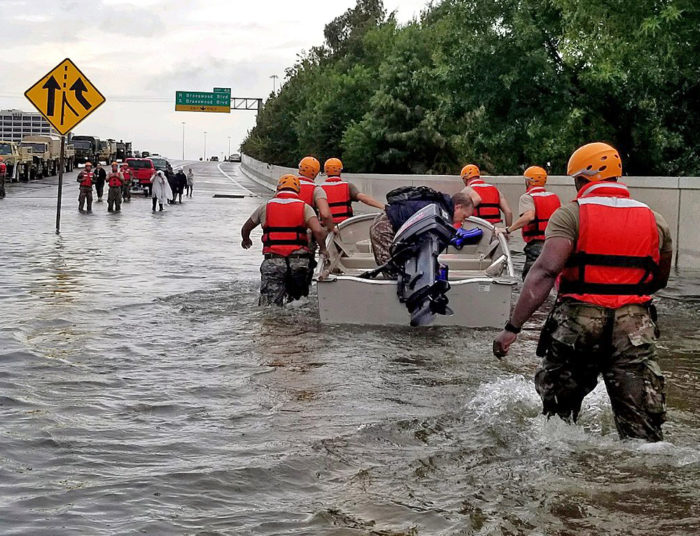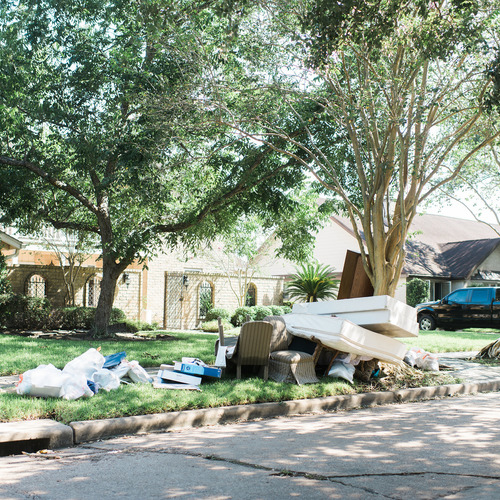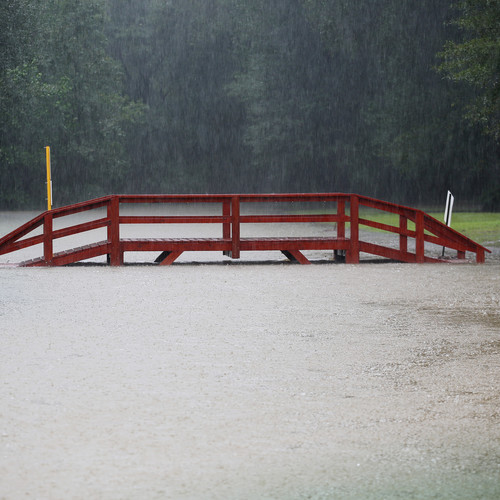
Image Credit: Wikipedia
For four days in late August 2017, the remnants of Hurricane Harvey dropped between 40 and 51 inches of rain on the Houston area, causing catastrophic flooding. Tens of thousands of homes have been severely damaged or destroyed, and dozens of people have lost their lives.
To those paying attention to real-estate development issues in Houston, the latest flooding, while unprecedented in scope, has followed a predictable pattern. Warning bells were rung in December 2016 by Texas Tribune reporters Neena Satija and Kiah Collier, authors of a prescient article titled “Boomtown, Flood Town.” When Satija and Collier interviewed Sam Brody, a Texas A&M University researcher, Brody told them, “More people die here than anywhere else from floods.” Satija and Coller reported, “Scientists, other experts and federal officials say Houston’s explosive growth is largely to blame. As millions have flocked to the metropolitan area in recent decades, local officials have largely snubbed stricter building regulations, allowing developers to pave over crucial acres of prairie land that once absorbed huge amounts of rainwater.”
In the aftermath of Hurricane Harvey, designers and builders are engaged in a soul-searching exercise. The construction community is asking a variety of questions about residential development in flood-prone regions and the wisdom of using government funds to rebuild homes in flooded areas.
I decided to pose some of these questions to Armando Cobo, a residential designer who lives and works in Texas.
Q. How many years have you been working in Texas?
Armando Cobo: I moved here 8 years ago. I design houses, and I help the builders manage or oversee the construction up until the framing inspection. Everything that we do is at the zero-energy level. I want to make sure that everything is done right, so I work with engineers, truss…
Weekly Newsletter
Get building science and energy efficiency advice, plus special offers, in your inbox.

This article is only available to GBA Prime Members
Sign up for a free trial and get instant access to this article as well as GBA’s complete library of premium articles and construction details.
Start Free TrialAlready a member? Log in













10 Comments
Hope things change
"Doing the same thing is no longer an option". Unfortunately it has proven to be the most commonly chosen option. I hope for the residents of Texas and other vulnerable regions it isn't the choice policy maker pick, but I wouldn't hold my breath.
Amando's interview was heartening. He may not be able to influence policy, but where he can influence clients he has made a real difference. A good role model for designers and builders anywhere.
Response to Malcolm Taylor
Malcolm,
Like you, I hope things change.
It's possible that Hurricane Irma will reinforce some of the lessons of Hurricane Harvey. According to today's New York Times (see image below), Florida "continues to encourage building in dangerous places."
.
Up Here
What I find frustrating about the high-profile floods that have made the news up here in Canada recently is the seeming inevitability once you look back on them.
- When the city of High River flooded, the vast majority of damage was to finished basements. Main floors, typically situated several steps up, were untouched. If you live in a town called High River, is it a good idea to build or finish a basement?
- Calgary suffered widespread property damage when houses built on the flood plain of the Bow River were inundated. Something that has happened periodically since the area was settled.
- Here in Vancouver Island there are communities that flood every spring. The amount of the damage depends on the extent of the flooding - but it happens to some extent every year.
Unlike some other natural disasters, flooding generally doesn't just come out of the blue. It is predicable, and the solutions involve simple measures that only get implemented when policy makers admit the problem exists.
The city of Vancouver commissioned a study predicting possible increases in sea levels due to climate change. All waterfront design and infrastructure is now being built to new standards taking this into account. Those sort of simple decisions, while politically difficult are what can mitigate the huge majority of these events.
Flooding in a town called High River
Your story about flooding in a town called High River reminds me of the famous mold complaints made by Melinda Ballard, a resident of Dripping Springs, Texas.
Glass Houses
I live on top of a fault line in a region where the code just added the first seismic requirements five years ago.
Dripping Springs. Ha ha!
IIBHS
Maybe the GBA could expand with follow up article(s) on resilient construction, not just flooding, but tornadoes, hail, earthquakes in the Midwest due to fracking, fire, etc.
I should have mention about the Insurance Institute for Building and Home Safety, and the great research work they are doing. They have come up with lots of good recommendations for different types of disasters, and offer a certification program. The average additional cost to build a house with FORTIFIED® resilient construction techniques is about $1,500. Watch this “cool” videos… https://vimeo.com/17764719
A couple of years ago, the House passed H.R. 3397, the Disaster Savings and Resilient Construction Act of 2015, which provides, up to $3,000 tax credit to owners and contractors who use resilient construction techniques for new and renovating structures in federally declared disaster areas, following the IIBHS certification.
Congress authorized $9.7 billion to cover insurance claims filed by folks whose homes were damaged or destroyed by Hurricane Sandy, plus a supplemental $50.7 billion package. That’s over $60 BILLION for folks to rebuild in the same location. All that money is usually not in the budget. In this day and age, we cannot afford to completely rebuild every time a disaster happens in the same area year after year..
After 12 years, over $100 BILLION were spent, though Congress, in recoveries after hurricanes Katrina, Rita and Wilma, and no telling how much more through the Red Cross and other organizations. Some folks in Houston are estimating the recovery costs as high as $200 BILLION. Is this insane? Or is it just me?
In short, EVERYONE PAYS FOR IT.
So why these areas are allow to rebuild without resilient construction? And in some areas, why are they rebuilding there at all?
100 year floods
My understanding is that the definition of a 100 year flood is a flood that has a 1% chance of occurring in any given year. Terms like 500 year flood or 1000 year flood are statistically unsupported. However, the expectations for what constitutes a 100 flood seem destined for recalibration in short order.
Armando
"So why these areas are allow to rebuild without resilient construction? And in some areas, why are they rebuilding there at all?"
As you say: that's the 200 billion dollar question.
Learning Curve
This year in Mid Michigan we had our second 100 year flood in 30 years. I was a kid during the first and remember that in my neighborhood the biggest problem wasn't the 1 to 2 feet of water in the basement but that it came from the sanitary sewer. 30 years later nothing has changed. This time I was depressed for a week after the flood, not because of the stuff people lost (let's face it the average person could throw away everything in their basement and probably not miss it for months) but because of the fleets of water restoration companies scurrying around town to put everything back the way it was, as quickly as possible.
Adding insult to injury...
In the last couple of days, here in North TX, I've talked to two builders who told me that framers are demanding higher prices or else they are going to Houston. As I say to Martin, things are going to get ugly for awhile, not just here in TX, but possibly in the Southeast as well.
Log in or become a member to post a comment.
Sign up Log in